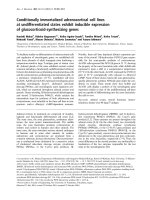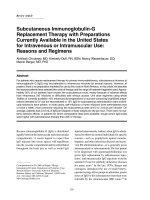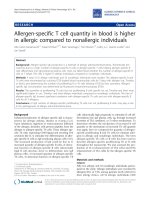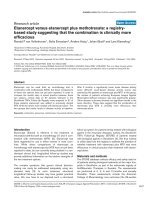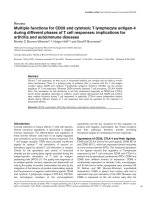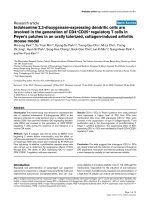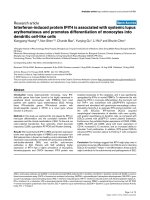Báo cáo y học: " High-risk HPV E5-induced cell fusion: a critical initiating event in the early stage of HPV-associated cervical cancer" pptx
Bạn đang xem bản rút gọn của tài liệu. Xem và tải ngay bản đầy đủ của tài liệu tại đây (205.18 KB, 3 trang )
HYPOTHESIS Open Access
High-risk HPV E5-induced cell fusion: a critical
initiating event in the early stage of
HPV-associated cervical cancer
Peng Gao
*†
, Jie Zheng
Abstract
Background: Cervical cancer is strongly associated with high-risk human papillomavirus (HPV) and viral
oncoproteins E5, E6 and E7 can transform cells by various mechanisms. It is proposed that oncogenic virus-induced
cell fusion may contribute to oncogenesis if p53 or apoptosis is perturbed simultaneously. Recently, HPV-16 E5 was
found to be necessary and sufficient for the formation of tetraploid cells, which are frequently found in
precancerous cervical lesions and its formation is strongly associated with HPV state.
Presentation of the hypothesis: We propose that high-risk HPV E5-induced cell fusion is a critical initiating event
in the early stage of HPV-associated cervical cancer.
Testing the hypothesis: Our hypothesis can be tested by comparing the likelihood for colony formation or
tumorigenic ability in nude mice between normal HaCaT cells expressing all three oncogenic proteins and E5-
induced bi-nucleated HaCaT cells expressing E6 and E7. Moreover, investigating premature chromosome
condensation (PCC) in HPV-positive and negative precancerous cervical cells is another way to assess this
hypothesis.
Implication of the hypothesis: This viewpoint would change our understanding of the mechanisms by which
HPV induces cervical cancer. According to this hypothesis, blocking E5-induced cell fusion is a promising way to
prevent the progression of cervical cancer. Additionally, establishment of a role of cell fusion in cervical
carcinogenesis is of reference value for understanding the pathogenesis of other virus-associated cancers.
Background
Cervical cancer progression is strongly associated with
infection of high-risk human papillomavirus (HPV) (e.g.,
HPV-16 and -18), which are detected in nearly all cervi-
cal cancers [1]. HPV is a small, nonenveloped DNA
virus expressing three key oncoproteins: E5, E6 and E7,
which posses s the ability of transforming certain human
cells in vitro and are considered to be associated with
cervical carcinogenesis in vivo [2-5]. E6 and E7 a re well
known for their ability to inhibit the function of tumor
suppressors p53 and pRb, respectively [6]. E5 has w eak
oncogenic properties which occur through increasing
epidermal growth factor receptor (EGFR ) and inhibiting
the expression of major histocompatibility complex
(MHC)-IandMHC-IIontheplasmamembrane[7].
Coexpression of E5 with eith er E6 or E7, however, pro-
motes transformation by either oncoprotein alone [8].
Recently, the view that oncogenic virus-induced cell
fusion may contri bute to oncogenesis is appealing as all
well-known human oncogenic viruses, including HPV,
Hepatitis B virus, Hepatitis C virus, Epstein-Barr virus,
Kaposi sarcoma virus and human T-lymphotropic virus
type 1, have fusogenic activity [9-11]. Researches show
that although most tetraploid cells resulting from non-
oncogenic-induced cell fusion would undergo p53-
dependent cell c ycle arrest or apoptosis, they, however,
survive and might be more prone to chromosomal
instability (CIN) if p53 or apoptosis is perturbed [12,13].
It is notable that all oncogenic viruses menti oned above
also possess proteins with these abilities [9]. As to HPV-
associated cervical cancer, this mechanism may be
operative as HPV-16 E5 was recently found to be
* Correspondence:
† Contributed equally
Department of Pathology and Pathophysiology, School of Medical Science,
Southeast University, Dingjiaqiao Road, Nanjing 210009, PR China
Gao and Zheng Virology Journal 2010, 7:238
/>© 2010 Gao and Zheng; licensee BioMed Central Ltd. This i s an Open Access article distributed under the terms of the Creative
Commons Attributio n License ( which permits unrestricted u se, di stribution, and
reproduction in any medium, provided the original work is properly cited.
necessary and sufficient for the formation of tetraploid
cells [10,11], which are frequently found in precancerous
cervical lesions and its formation is strongly associated
with HPV state [14,15].
Tetraploid cells in precancerous cervical lesions
Tetraploid cervical cells are often observed in precancer-
ous lesions, and it has been established as a prognostic
factor that allows to estimate the relative progression
risk into more advanced lesions [15]. Moreover, aneu-
ploid cells are frequently observed in these precancerous
lesions. It is, therefore, proposed that a sequential pat-
tern of chromosomal aberrations occurs during cervical
carcinogenesis, where aneuploidy develops through
chromosomal loss from a tetraploid intermediate.
Ano ther study investigated both tetraploid cervical cells
and HPV state in precancerous cervical cells, results
showed that tetraploid cervical cells were elevated in
women diagnosed as either atypical squamous cells of
undetermined significance (ASCUS)/HPV-positive or
low-grade squamous intraepithelial lesion (LSIL)/HPV-
positive as compared with normal/HPV-negative
women, indicating that formation of tetraploid cells is
obviously associated with HPV infection [14].
HPV-16 E5 induces cell-cell fusion
HPV-16 E5 has all the characteristics of fusogenic pro-
teins, including localization to the plasma membrane,
high level of hydrophobicity, and the ability for dimmers
[3]. Until recently, HPV-16 E5, however, has been iden-
tified to be necessary and sufficient to induce cell-cell
fusion [10]. It is worth mentioning that HPV-16 E5
must be expressed on both cells for cell fusion to occur
[11]. It is also found that tetraploid cells were produced
with greater than a 3-fo ld frequency upon introduction
of the HPV-16 genome into spontaneously immortalized
human keratinocyt es (HaCaT) as compared to cells
transfected with an HPV-16 genome harboring a mutant
E5 gene. By contrast, low-risk HPV-6b E5 could not
induce cell fusion [10].
Based on the observations mentioned above, we
hypothesize that high-risk HPV E5-induced cell fusion is
a critical event in the early stage of HPV-associated cer-
vical cancer.
Presentation of the hypothesis
The fact that aneuploid cells are frequently observed in
precancerous lesions with elevated proportion of tetra-
ploid cells, the formation of which is obviously asso-
ciated with HPV infection [14] suggests that formation
of tetraploid cells is a critical event in cervical carcino-
genesis, but the detail formation mechanism of tetra-
ploidyisnotclear.Itisreportedthatexpressionof
either HPV E6 or E7 alone is sufficient to deregulate
cytokinesis and consequently produce tetraploid cells
[16,17]. However, Hu et al. demonstrated that the for-
mation of these cells is primarily attributed to E5 and
E5-induced cell fusion, rather than E6, E7 and cytokin-
esis failure [10].
Tetraploid cells formed by accident can not undergo
normal mitosis which would trigger p53-dependent cell
cycle arrest or apoptosis [12,13], whereas, oncogenic
virus-induced cell fusion is sufficient to induce CIN
when fusion occurs concomitantly with expression of
viral oncoproteins capable of perturbing p53 or apopto-
sis [12]. Consistently, although most tetraploid cells die
out, whereas, coexpression of HPV-16 E6/E7 enhances
the proliferation of these cells and the likelihood for col-
ony formation elevates 3-fold [10].
Based on the observations mentioned above, we pro-
pose that high-risk HPV E5-induced cell fusion may
play a critical role in the early stage of HPV-associated
cervical cance r. However, it is widely accepted that
increasingly deregulated e xpression of the E6-E7 onco-
genes of hig h-risk HPVs has been identified as the
major transforming factor in the pathogenesis of cervical
dysplasia and derived cancers [2]. In fact, these two
mechanisms are not mutually exclusive as E5 functions
only in the early stage, whereas, E6 and E7 act through-
out the carcinogenesis. Additionally, it is notable that
expression levels of all three oncoproteins in host cell
are low for tight restriction in the early stage, and
expression of E5 is nearly not detectable in all late
stages for integration [3]. Moreover, the ability of E6
and E7 to transform various cells have been demon-
strated only in over expression systems, therefore,
whether it also occurs in natural settings is not known.
We also notice that in vitro [18,19] and clinic studies
[20] reveal that chromosomal instabilit y and aneuploidi-
zation seem to precede and favor integration of HPV
genomes, which in turn leads to expression of viral-cel-
lular fusion transcripts and further enhances expression
of the E6-E7 genes, which renders transformed cells
strong growth advantages [21].
Testing the hypothesis
In order t o determine whether high-risk HPV E5-
induced cell fusion is important for initial transforma-
tion, we can compare the likelihood for colony forma-
tion o r tumorigenic ability in nude mice between
normal HaCaT cells expressing all three oncogenic pro-
teins and E5-induced bi-nucleated HaCaT cells expres-
sing E6 and E7. In our hypothesis, cell fusion and cell
cycle deregulation are two key events for initiation of
transformation. Therefore, inhibition of cell fusion
should significantly decrease the likelihood for transfor-
mation. Moreover, investigating premature chromosome
condensation (PCC) in HPV-positive and negative
Gao and Zheng Virology Journal 2010, 7:238
/>Page 2 of 3
precancerous cells is another way to test this hypothesis.
PCC refers to condensation of interphase chromosomes
following fusion between aninterphaseandamitotic
cell [22], and it can be used as a tool to detect the exis-
tence of cell fusion [23].
Implication of the hypothesis
Understanding the cause of cancer is critical for effective
diagnosis, prevention and therapy. The recent view that
human oncogenic virus-induced cell fusion can initiate
cancer is an appealing mechanism. In this article, we
propo se that high-risk HPV E5-induced cell fusion is an
important event in the early stage of HPV-associated
cervical cancer. This viewpoint will change our under-
standing of the mechanisms by which HPV induces cer-
vical cancer. According to this hypothesis, blocking
HPV E5-induced c ell fusion is a promisi ng way to pre-
vent the progression of cervical cancer. Additionally,
establishment of a role of cell fusion in carcinogenesis
of cervical cancer is of reference value for understanding
the pathogenesis of other virus-associated cancers.
Acknowledgements
This material is based upon work supported by National Natural Science
Foundation of China, Natural Science Foundation of Jiangsu Province,
Foundation of Graduate School of Southeast University.
Authors’ contributions
Both authors contributed equally to this manuscript. Both authors read and
approved the final manuscript.
Competing interests
The authors declare that they have no competing interests.
Received: 10 July 2010 Accepted: 16 September 2010
Published: 16 September 2010
References
1. zur Hausen H: Papillomavirus infections–a major cause of human
cancers. Biochim Biophys Acta 1996, 1288:F55-78.
2. Liu Y, Chen JJ, Gao Q, Dalal S, Hong Y, Mansur CP, Band V, Androphy EJ:
Multiple functions of human papillomavirus type 16 E6 contribute to
the immortalization of mammary epithelial cells. J Virol 1999,
73:7297-7307.
3. Zerfass K, Schulze A, Spitkovsky D, Friedman V, Henglein B, Jansen-Dürr P:
Sequential activation of cyclin E and cyclin A gene expression by
human papillomavirus type 16 E7 through sequences necessary for
transformation. J Virol 1995, 69:6389-6399.
4. Wazer DE, Liu XL, Chu Q, Gao Q, Band V: Immortalization of distinct
human mammary epithelial cell types by human papilloma virus 16 E6
or E7. Proc Natl Acad Sci USA 1995, 92:3687-3691.
5. Leechanachai P, Banks L, Moreau F, Matlashewski G: The E5 gene from
human papillomavirus type 16 is an oncogene which enhances growth
factor-mediated signal transduction to the nucleus. Oncogene 1992,
7:19-25.
6. Narisawa-Saito M, Kiyono T: Basic mechanisms of high-risk human
papillomavirus-induced carcinogenesis: roles of E6 and E7 proteins.
Cancer Sci 2007, 98:1505-1511.
7. Tsai TC, Chen SL: The biochemical and biological functions of human
papillomavirus type 16 E5 protein. Arch Virol 2003, 148:1445-1453.
8. Stöppler MC, Straight SW, Tsao G, Schlegel R, McCance DJ: The E5 gene of
HPV-16 enhances keratinocyte immortalization by full-length DNA.
Virology 1996, 223:251-254.
9. Duelli D, Lazebnik Y: Cell-to-cell fusion as a link between viruses and
cancer. Nat Rev Cancer 2007, 7:968-976.
10. Hu L, Plafker K, Vorozhko V, Zuna RE, Hanigan MH, Gorbsky GJ, Plafker SM,
Angeletti PC, Ceresa BP: Human papillomavirus 16 E5 induces bi-
nucleated cell formation by cell-cell fusion. Virology 2009, 384:125-134.
11. Hu L, Ceresa BP: Characterization of the plasma membrane localization
and orientation of HPV16 E5 for cell-cell fusion. Virology 2009,
393:135-143.
12. Duelli DM, Padilla-Nash HM, Berman D, Murphy KM, Ried T, Lazebnik Y: A
virus causes cancer by inducing massive chromosomal instability
through cell fusion. Curr Biol 2007, 17:431-437.
13. Andreassen PR, Lohez OD, Lacroix FB, Margolis RL: Tetraploid state induces
p53-dependent arrest of nontransformed mammalian cells in G1. Mol
Biol Cell 2001, 12:1315-1328.
14. Olaharski AJ, Eastmond DA: Elevated levels of tetraploid cervical cells in
human papillomavirus-positive Papanicolaou smears diagnosed as
atypical squamous cells of undetermined significance. Cancer 2004,
102:192-199.
15. Olaharski AJ, Sotelo R, Solorza-Luna G, Gonsebatt ME, Guzman P, Mohar A,
Eastmond DA: Tetraploidy and chromosomal instability are early events
during cervical carcinogenesis. Carcinogenesis 2006, 27:337-343.
16. Incassati A, Patel D, McCance DJ: Induction of tetraploidy through loss of
p53 and upregulation of Plk1 by human papillomavirus type-16 E6.
Oncogene 2006, 25:2444-2451.
17. Heilman SA, Nordberg JJ, Liu Y, Sluder G, Chen JJ: Abrogation of the
postmitotic checkpoint contributes to polyploidization in human
papillomavirus E7-expressing cells. J Virol 2009, 83:2756-2764.
18. Duensing S, Duensing A, Flores ER, Do A, Lambert PF, Münger K:
Centrosome abnormalities and genomic instability by episomal
expression of human papillomavirus type 16 in raft cultures of human
keratinocytes. J Virol 2001, 75:7712-7716.
19. Duensing S, Duensing A, Crum CP, Münger K: Human papillomavirus type
16 E7 oncoprotein-induced abnormal centrosome synthesis is an early
event in the evolving malignant phenotype. Cancer Res 2001,
61:2356-2360.
20. Melsheimer P, Vinokurova S, Wentzensen N, Bastert G, von Knebel
Doeberitz M: DNA aneuploidy and integration of human papillomavirus
type 16 e6/e7 oncogenes in intraepithelial neoplasia and invasive
squamous cell carcinoma of the cervix uteri. Clin Cancer Res 2004,
10:3059-3063.
21. Ziegert C, Wentzensen N, Vinokurova S, Kisseljov F, Einenkel J, Hoeckel M,
von Knebel Doeberitz M: A comprehensive analysis of HPV integration
loci in anogenital lesions combining transcript and genome-based
amplification techniques. Oncogene 2003, 22:3977-3984.
22. Johnson RT, Rao PN: Mammalian cell fusion: induction of premature
chromosome condensation in interphase nuclei. Nature 1970,
226:717-722.
23. Kovacs G: Premature chromosome condensation: evidence for in vivo
cell fusion in human malignant tumours. Int J Cancer 1985, 36:637-641.
doi:10.1186/1743-422X-7-238
Cite this article as: Gao and Zheng: High-risk HPV E5-induced cell
fusion: a critical initiating event in the early stage of HPV-associated
cervical cancer. Virology Journal 2010 7:238.
Submit your next manuscript to BioMed Central
and take full advantage of:
• Convenient online submission
• Thorough peer review
• No space constraints or color figure charges
• Immediate publication on acceptance
• Inclusion in PubMed, CAS, Scopus and Google Scholar
• Research which is freely available for redistribution
Submit your manuscript at
www.biomedcentral.com/submit
Gao and Zheng Virology Journal 2010, 7:238
/>Page 3 of 3



